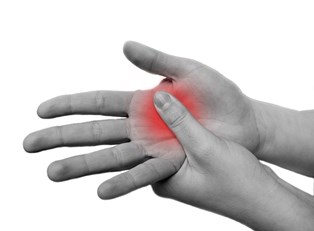Osteoarthritis (degenerative joint disease; osteoarthrosis) is the most common form of arthritis, affecting nearly 21 million Americans. It occurs when cartilage in one's joints degrade over time, usually in the hands, wrists, hips, knees, neck and lower back. Cartilage is a firm, but elastic, material that reduces friction in the joints to serve as a natural shock absorber.
Osteoarthritis causes the cartilage to stiffen, making it susceptible to damage and deterioration over time. The nearby tendons and ligaments stretch in reaction to this, which causes pain. The chance of developing the disease increases with age, but even people in their 20s and 30s can develop the condition. Aside from age, there are several factors that contribute to osteoarthritis. Heredity: Some have inherited a gene that causes the creation of defective cartilage, which leads to rapid joint deterioration. Obesity: Extra body weight increases the risk of osteoarthritis in the knees and hips. Injury: Torn ligaments, strained muscles, dislocated joints, and any other injury increases the risk of osteoarthritis. Overuse: A job requiring repetitive motion over an extended period of time, causes joint overuse and consequently increases the chance of developing osteoarthritis. Though widely accepted, there is no evidence that cracking ones knuckles leads to osteoarthritis.
Osteoarthritis Symptoms
Osteoarthritis symptoms develop slowly and become more severe over time. Signs and symptoms may include any one, or a combination of, the following. One may feel pain in a joint during, or after, movement. One might experience tenderness in the joint when applying light pressure to it. Stiffness in joints may occur, particularly in the morning or after an extended period of inactivity. One may feel, or even hear, a grating sensation during joint use. An extra bit of bone, known as a bone spur may form around an affected joint. All of these contribute to the main osteoarthritis symptom, which is joint pain. This in turn causes the loss of ability to use the joint comfortably. The pain is commonly described as a sharp ache in the joint or a burning sensation in the surrounding muscles and tendons. In addition to a grating sound, affected joins can cause a crackling noise (crepitus), and the individual may experience muscle spasms. The joints may also fill with fluid, and as osteoarthritis progresses, the affected joints appear larger. Hard, bony enlargements, called nodes, may form in smaller joints, such as the fingers, and osteoarthritis may also lead to bunions on the toes.
Osteoarthritis Treatment
One should consult a physician if he or she is experiencing swelling and/or stiffness in the joints for more than two weeks. Osteoarthritis diagnosis is based on medical history and clinical examination, usually including x-rays. There is no known cure; however, osteoarthritis treatment can generally be categorized into three main areas: Physical Therapy, Lifestyle Modification, and Medication. Physical therapy for osteoarthritis strengthens muscles with controlled exercises, usually conducted with a Physical Therapist. These exercises will also increase the joint(s) range of motion and reduce pain. Changes in daily routine and lifestyle can also slow the degeneration and reduce osteoarthritis pain. Moderate, gentle exercise, such as swimming, is recommended. Maintain a healthy, doctor-recomm ended body weight to protect joints and avoid unnecessary stress on the hips and knees. Lastly, there are medications available to reduce pain. Over-the-counter pain relievers include acetaminophen (Tylenol), and anti-inflammatory drugs (NSAIDs), such as aspirin, ibuprofen, or Celebrex. Some topical creams, rubs, and sprays can be applied to the skin around affected areas to relieve pain. Prescription drugs approved for osteoarthritis pain include the antidepressant, Cymbalta. Synvisc, Supartz, Euflexxa, Orthovisc, and Hyalgan can be administered as a series of three to five weekly joint injections to relieve knee pain specifically.



